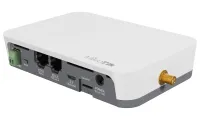MikroTik KNOT IoT Gateway LoRa CAT-M NB Bluetooth GPS 2x LAN 1x SIM microUSB 2.4 GHz b g n L4
MIKROTIK | RB924iR-2nD-BT5&BG77&R11e-LR8 | 4752224007858

Price of goods is 181.51 €.
Price without tax is 150.01 €.
Weight of goods is 0.45 Kg.
Actual in cart 0 pcs.
MikroTik KNOT LR8 kit
The KNOT LR8 kit is a complete universal device with a wide range of connection options and support for protocols or interfaces. It is an IoT Gateway for LoRa technology for maximum versatility and efficiency. The device uses Narrow Band and CAT-M technologies, which, due to the very low monthly price (compared to LTE) and low bandwidth usage, are supported by countless mobile operators around the world including the Czech Republic. This kit includes a pre-installed UDP packet router for any public or private LoRa (868 or 915 MHz) servers.
- LoRa support (868 or 915 MHz) - SMA female connector
- GPS support (GPS, GLONASS, BeiDou, Galileo) - SMA female connector
- Support for Narrow Band and LTE Cat M1 technology - SMA female connector
- Integrated Wi-Fi (802.11b/g/n)
- 2x RJ-45 10/100 Mbps (1x PoE IN, 1x PoE out)
- Built-in Bluetooth 5.2 connection (2 dBi integrated antenna)
- RouterOS operating system with L4 license
- SIM card slot (Nano SIM)
- Extra RS-485/Modbus and GPIO interface
- Wide operating temperature -40 to +70 °C
- Wide range of power supply: DC connector, PoE, Micro USB
LoRa is one of the wireless network protocols used in the world of Internet of Things - IoT (Internet of Things)
LoRaWAN (Long Range Wide Area Network) is another low-power wireless network protocol designed for low-cost and secure two-way communication in the Internet of Things. It uses a band up to 1 GHz and the transfer speed is then from 0.3 kb/s to 50 kb/s. Communication between end elements and gateways is spread over different frequency bands and transmission rates. The choice of data transfer rate is a compromise between communication range and message length. Individual communication streams with different transmission rates do not interfere with each other (due to spread spectrum technology) and create a set of "virtual" channels to increase gateway capacity. To maximize end device battery life and overall network capacity, the LoRaWAN network server manages the baud rate and RF output for each end device individually, through an Adaptive Data Rate (ADR) system
LoRaWAN distinguishes several classes of devices
- Class A - end devices support two-way communication (each uplink is followed by two windows for receiving data
- Class B - apart from the "forced" downlink of class A, devices of this class open extraordinary reception windows at set times
- Class C - receiving windows are open almost continuously and close only when transmitting
Package contents
- Device (KNOT IoT Gateway LoRa
- Power adapter
- DIN rail mounting kit
- USB A - USB Micro B cable Set of screws and dowels
Interface
- Modbus/RS-485
- LAN
- WiFi
- Bluetooth
- LTE (Narrow Band, CAT-M)
- GNSS (optional)
- LoRA
Wi-Fi standard: IEEE 802.11b/g/n (2.4GHz)
Processor and memory
- QCA9531 650 MHz
- 64 MB of RAM
- 128 MB SPI NAND flash
Antenna
- 360°
- internal (2 + 1.5 dBi)
- 3× SMA connector (NB/CAT-M
- GNSS
- LoRa
Ports
- 2x RJ-45
- 1× SIM slot (nano)
- 1x terminal block (modbus/RS-485)
- 3× SMA (F)
- 1x microUSB
PoE support
- yes
- passive 12-57 V (input)
- active 802.3af/at (output)
Dimensions: 122 x 87 x 26 mm
| Name | Value | |
|---|---|---|
| Color | white - gray | |
| Dimension [mm] | 122 × 87 × 26 mm | |
| Minimum operating temperature [°C] | -40 | |
| Maximum operating temperature [°C] | 70 | |
| SIM slot | Yes | |
| Conformity | Bluetooth, CE, FCC, IC | |
| Power supply [V] | 5 | |
| Micro USB count | 1 | |
| Wi-fi | Yes | |
| Antenna design | without own antenna (SMA) | |
| Gain [dBi] | 1,5 (Wi-Fi), 2 (BT) | |
| Max. output power [dBm] | 22 | |
| Wi-Fi frequency | 2400 MHz | |
| Number of connectable antennas | 3 | |
| Sensitivity [dBm] | -93 (Bluetooth, 1M) | |
| Wi-Fi standard | 802.11b/g/n | |
| Port speed | 100 Mb/s | |
| Design | DIN rail | |
| Outdoor use | No | |
| Type of accessory | IoT gateway | |
| RJ-45/RJ-11 count | 2 | |